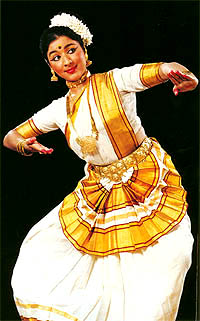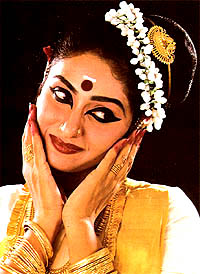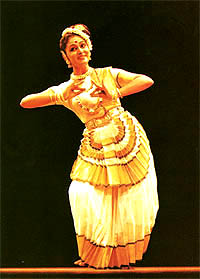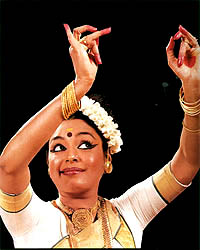Mohiniattam Style
The history of origin of the Mohiniattam dance tradition (literary "Dance of a
Charmer") traces back into the deep past of Kerala, the state in the south-west
of India. Its modern form performed exclusively by women, however appeared not
so long ago and was called up
 by
the creative works of such dancing companies as Kaykottikali, Tiruvatirakali and
Nanjyar Kutu performing their compositions at various public celebrations.
Nanjyar Kutu is a variant of female performance of a rather stylized Kutiyattam
which in its turn is a survived successor to the so-called Sanskrit theatre. The
Mohiniattam’s repertoire that does not reveal any traces with the temple
tradition nevertheless bears a certain element of initiation. The scientists of
Kerala say that no traces of women-devadasis have been found in the history of
this region, any evidences disproving this point of view supposedly come from
the state of Tamilnadu that once was historically connected with Kerala. by
the creative works of such dancing companies as Kaykottikali, Tiruvatirakali and
Nanjyar Kutu performing their compositions at various public celebrations.
Nanjyar Kutu is a variant of female performance of a rather stylized Kutiyattam
which in its turn is a survived successor to the so-called Sanskrit theatre. The
Mohiniattam’s repertoire that does not reveal any traces with the temple
tradition nevertheless bears a certain element of initiation. The scientists of
Kerala say that no traces of women-devadasis have been found in the history of
this region, any evidences disproving this point of view supposedly come from
the state of Tamilnadu that once was historically connected with Kerala.
There is a row of historical evidences proving the existence of Tali Nanjyar or
female performers of solo dance (literary: Tali-temple, Nanjayr – woman). The
records of Chollur (932 AD) and Nedumpar Tali (934 AD) mention a certain
Chittarayil Nanjayr who granted the temple lands and money to Nanjayr and
Nattuvanar. In Manipravala Champu Sukhasandesam relating to XIII century AD a
performance in Trikkanamatikalam temple is described. In a treatise named
Manipravala Kavjas there is a mention of a female dancer who danced under names
Unni, Unniyadi, Unnicherutevi, Cherukara Kuttati and Uniyachi. Female dancers
usually served only in Suchindram and Tripunitura temples mainly performing
dances to Tamil lyrics.
There were three kinds of Tali Nanjyar (dancers): Uttama or a noble woman mainly
of aristocratic origin who was made to give a vow of chastity; Madhyama serving
to tantrists during a kriya ritual; and Dasis destined for rough daily work. A
pure religious dance Avayavam was performed as a rule in a sitting position
under the reading of a short poem Pann or a chanting and included little
footwork under the rhythm of one bell. According to historians Tali Nanjyars
were never tied to any deity like devadasis. Unfortunately by the beginning of
XIV century there had little left from the conservative and isolated Tali
Nanjyar style. By XVI-XVII centuries such dramatized dance styles as Krishnattam,
Ramanattam and later Kathakali that glorified male dancers had slightly pressed
female solo performance. Some historians think this happened because practically
nobody was allowed to see Tali Nanjyar dance. The only female tradition Nanjyar
Kutu could survive only because Kutiyattam acquired protection of the temple.
For the first time the word Mohini appears in the Malayalama commentary of the
XVII century in "Vyavaharamala" that was composed two centuries later by
Majamangalam Narayann Nambudiri. Much later in his work "Goshayatra", Kunjan
Nambiyar the creator of Ottam Tullal also mentions Mohiniattam. Such names as
Mohinilaye and Mohinistana can be found with Maharaja Kartik Tirunal Malarama
Verma (1724-1798) in "Balaramabharatea" one of the most significant treatises on
the art of performance of XVIII century Kerala. None of these texts gives an
idea of the form of the dance most widely spread in that period.
Due to a public custom of Kerala for men-Nambudiri (Sanskrit cultural tradition)
and women-Nairis (a military tradition of Keral) to enter into an alliance, the assimilation of their cultures led to the appearance of
various kinds of art. Tampuranas born from the marriages of Kshatri princes with
Nambudiri women became the sole rulers of Kerala princedoms. But by the
beginning of the XIII century there had left only 3 main royal houses: Zamorin
in Calcutta, Raja in Kochin and Travankor and they became the last of the royal
families where succession down the female line can be traced. In the end of XVII
century the regent’s grandson Asvati Tirunal Umayamma Rani a famous vayshnav
Martanda Verma proclaimed that his successors from that time on would rule as
deputies of Lord Vishnu in the image of Padmanabha (a sovereign ruler of lands).
Since then the worshipping of Lord Vishnu has become the characteristic feature
of this region. But besides Vishnu they also worship Bhagavati a mighty female
deity whose cult has a strong tantric hue, and Hariharaputra Ayyapp born as an
alliance of Shiva and Vishnu who put upon himself the image of a beauty Mohini.
In fact nayika (a heroine) in Mohiniattam is always portrayed as longing for
Lord Padmanabha.
into an alliance, the assimilation of their cultures led to the appearance of
various kinds of art. Tampuranas born from the marriages of Kshatri princes with
Nambudiri women became the sole rulers of Kerala princedoms. But by the
beginning of the XIII century there had left only 3 main royal houses: Zamorin
in Calcutta, Raja in Kochin and Travankor and they became the last of the royal
families where succession down the female line can be traced. In the end of XVII
century the regent’s grandson Asvati Tirunal Umayamma Rani a famous vayshnav
Martanda Verma proclaimed that his successors from that time on would rule as
deputies of Lord Vishnu in the image of Padmanabha (a sovereign ruler of lands).
Since then the worshipping of Lord Vishnu has become the characteristic feature
of this region. But besides Vishnu they also worship Bhagavati a mighty female
deity whose cult has a strong tantric hue, and Hariharaputra Ayyapp born as an
alliance of Shiva and Vishnu who put upon himself the image of a beauty Mohini.
In fact nayika (a heroine) in Mohiniattam is always portrayed as longing for
Lord Padmanabha.
As a symbol of calm energy Lord Vishnu lies on rings-twined serpent Shesh and
embodies the power of steadiness and the unity of the Universe. There is a
legend according to which Vishnu put upon himself the image of a charmer Mohini
when gods and demons churned the Causal Ocean hoping to obtain Amrita (elixir of
immortality) and could not decide who it will go to. Then Mohini charmed the
demons, took the vessel with the elixir from them and gave it to the gods. She
also came to the aid of Lord Shiva who was chased by demon Bhasmasura. This
demon got a gift from Shiva to destroy anyone he puts his hand on. And he wanted
to use this gift against Shiva himself. But Mohini drew him from the chasing by
promising he would own her if he only exceeds her in a dance contest. By making
Bhasmasura repeat her every move Mohini finally made the demon put his hand on
his own head thus turning him into ashes.
The murals of Padmanabhapurama and Mattancheri palaces prove the popularity of
myths about Mohini. Thus the word combination Mohiniattam denotes either a
dancer-charmer or dance-magic. According to experts, the dance tradition of
Mohiniattam being the embodiment of the magic of enchantment makes a stress
exactly on dance by means of which a male deity transforms into a female one.
A reformer Vallatol found traces of the dance long before the appearance of
Silappadikaram due to the mention of Chakyaras of Kerala
 (a
royal dynasty) while such explorers as Pisharoti stated that the dance had 600
years of history. A dancer Kanak Rele insists that the aspects of female dance
discussed in Balaramabharatam must be referred to Mohiniattam because the hastas
described there differ from the descriptions of Hastalakshanadipika, another
important treatise related to the Kathakali tradition. One cannot exclude
Dasiattama’s influence. Ullur Parameshvara Iyer notices in his Malayalama
commentary that Maharaja Svati Tirunal being absorbed by the art of Dasiattama
ordered his courtier Karutedatta Chomatiri to popularize this style under the
name Mohiniattam. (a
royal dynasty) while such explorers as Pisharoti stated that the dance had 600
years of history. A dancer Kanak Rele insists that the aspects of female dance
discussed in Balaramabharatam must be referred to Mohiniattam because the hastas
described there differ from the descriptions of Hastalakshanadipika, another
important treatise related to the Kathakali tradition. One cannot exclude
Dasiattama’s influence. Ullur Parameshvara Iyer notices in his Malayalama
commentary that Maharaja Svati Tirunal being absorbed by the art of Dasiattama
ordered his courtier Karutedatta Chomatiri to popularize this style under the
name Mohiniattam.
Two brothers from Tanjor quartet, Vadivelu and Shivanandam, after the fall of
the Maratha kingdom in Tanjor moved to Maharaj Tirunal palace following dancers
Nirajakshi and Satyabhama. Maharaja is said to marry a dancer Sugandhavalli.
Being a poet and composer himself Tirunal created compositions for the female
dancing tradition. A Tajor musician Parameshvara Bhagavatar was also a
decoration of his palace. That’s why it is not surprising that excluding
Cholketta that included nrytta (rhythmic not subject dance) and reminded Shabdam
in Dasiattama with its stress on lyrics dedicated to God and which was performed
instead of Alaripa (a dance-greeting), the character of performing dances was
similar to Bgaratanatyam especially in such compositions as Jatisvaram, Varnam,
Padam and Tillana. Music was also Karnatik. After Tirunal’s death the British
authorities sent in haste everything that left from the tradition of solo female
dance art to the Central Kerala.
That’s why when Vallatol and Mukunda Raja began to reconstruct the Kerala dance,
the solo female dance did not correspond to their high cultural standards. Such
existing dances as Mukutti based on song "Aendamukkutti kandatundo" ("Have you
seen my nose ringlet?") and Kalabham Kutu, rather primitive in edited versions,
seemed more suited for entertainment. In these dances a dancer first came to one
man then to another in search of her ring as if asking by gestures: "Have you
seen my nose ringlet?" It was improper to come so close to a spectator. But in
spite of rather defiant gestures some witnesses state that both movements and
abhinaya of dancers were not without artistic skills. In another composition,
Kalabham kutu, a dancer playing the role of a nayika (a heroine in love) while
preparing to meet her beloved praised the cooling effect of sandal paste that is
put on body to assuage the fever of unshared love. When the British came, the
Great Britain’s diplomatic representative colonel Monroe imposed an official ban
on Mohiniattam in states Travankor and Kochin.
Kavalam Narayana Panikar and other authors worked hard on creating modern music
for Mohiniattam with the purpose to give it a completely local sound. Neither
excessive slow theater music of Kathakali, nor stylized ritual music of
traditions like Mudiyettu that appealed to the awe inspiring aspect of goddess
Bhagavati, did not correspond to the music of Mohiniattam, the dance of
seduction.
The local music Sopanam reminded the hymns Taveram that were performed in
Tamilnadu temples. According to Leela Omcheri, the term Sopanam denoting "step"
(padi) in Sanskrit relates to a stepped musical structure where every note of
ascending or descending scale becomes a pause, and a singer’s voice as if
vibrates around this note till it passes to another. Starting with a free scale
or shaj, Sopanam in its resurrected form is performed in a slowly increasing
tempo.
The geometry of motions and the basic technique of Mohiniattam reflect the
unforgettable images of Kerala nature: coco palm leaves waving in the wind, boats rocking on water and creating patterns from radiating
circles. This is the endless source of energy unrolling spirally like gradually
awoken Kundalini Shakti (sleeping energy) crawling up the spinal column. There
is no point to symbolize the beginning or the end in circular vortexes. This is
the churning of the ocean resulted in Mohini’s appearance, she came out of the
same waters where Lord Vishnu laid on his bed of serpent rings. All these images
seem to unite in Mohiniattam in smooth circular body movements forming the
central element of the dance. Flexibility of waist, shoulders, elbows and wrists
is developed within the frames of andolika and cannot go beyond the limits of
stated norms. The motion starts from the center of body and shifts to limbs or
on the contrary starts in limbs and shifts to the center. Simultaneously with
the rocking body the lower part of it is in the semi-plíe position with knees
moved asides forming rather a square than a triangle. To tell the truth there is
no common opinion as to the distance between feet. Eye movements are not as
subtle as in Kathakali but are lively enough. Elegancy and nobleness emphasize
the snow white costume with a golden edging, the specially modeled attire that
replaced 9 meter sari that was in fashion 35-40 years ago.
waving in the wind, boats rocking on water and creating patterns from radiating
circles. This is the endless source of energy unrolling spirally like gradually
awoken Kundalini Shakti (sleeping energy) crawling up the spinal column. There
is no point to symbolize the beginning or the end in circular vortexes. This is
the churning of the ocean resulted in Mohini’s appearance, she came out of the
same waters where Lord Vishnu laid on his bed of serpent rings. All these images
seem to unite in Mohiniattam in smooth circular body movements forming the
central element of the dance. Flexibility of waist, shoulders, elbows and wrists
is developed within the frames of andolika and cannot go beyond the limits of
stated norms. The motion starts from the center of body and shifts to limbs or
on the contrary starts in limbs and shifts to the center. Simultaneously with
the rocking body the lower part of it is in the semi-plíe position with knees
moved asides forming rather a square than a triangle. To tell the truth there is
no common opinion as to the distance between feet. Eye movements are not as
subtle as in Kathakali but are lively enough. Elegancy and nobleness emphasize
the snow white costume with a golden edging, the specially modeled attire that
replaced 9 meter sari that was in fashion 35-40 years ago.
The temples of Keral also absorbed the elements of a circle, and are rich in
rounded kerbs unlike the terrifying verticality and engraved lines of Tamilnadu
temples. The same aesthetics is reflected in editing of dances. In Mohiniattam
it is the body movements, andolika, that echo the curls of musical patterns.
Aedekka, a percussion instrument used in Mohiniattam is also called "a singing
drum". A certain rounded softness is inherent with it, the softness that is
different from the chiseled accuracy of Sollukattas in Bharatanatyam or bolas in
Kathak.
Modern Mohiniattam is a polished version of the style that has undergone
significant changes. Initially the teachers of Mohiniattam were men. When the
famous school Kalamandalam just headed for its creative flight in Mohiniattam,
Guru Krishna Panikkar had already had in his repertoire shortened Varnam, Padam
and such compositions as Rasakrida and Gopi-vastrapaharanam that are similar in
many ways to Krishnattam tradition and group dances of Kaykottikali and
Tiruvadirakkali. Footwork (steps) included the elements of Tullala, Padayanis
and Ardjunanryttam. Kalyani Amma one of the earliest Kalamandalam teachers (about
1933-34) offered the number similar to Tarana and called it Hindustani.
Kalpuratte Kunjukuttyamma who was trained under the guidance of a whole pleiad
of teachers – Gopal Pannikar, Kunjan Panikkar, Krishna Menon and Puliyankotte
Aschyutan Nair- performed a sari-dance as a prelude to Vernam. Famous for their
elegance Tottacheri Chinnammu Amma, Thankamani (who later became Guru
Mohiniattam Gopinath’s wife) and many other female dancers performed their
dances without stylistic coordination.
When Vallattol persuaded the now deceased Kalyanikuttyama to go in for
Mohiniattam, the social prejudices against this dance form
 were
very strong. When she joined the Kerala troupe of Kalamandalam School in 1930s,
Kalyanikuttyama even abstained from visiting her sister’s wedding so that
bridegroom’s relatives did not have wrong impression of the bride’s family. In
1940 after a humble wedding ceremony with a Kathakali maestro Krishnan Vair,
Kalyanikuttyama settled in Tripunitura where afterwards in 1958 together with
her husband she founded a school. With her reserved andolika and original
expression Kalyanikuttyama perhaps unconsciously gave Mohiniattam the accuracy
of Bharatnatyam for both her daughters, Shridaevi and Kaladaevi studied
Bharatnatyam with Guru Bhackar Rao from Tanjavur. were
very strong. When she joined the Kerala troupe of Kalamandalam School in 1930s,
Kalyanikuttyama even abstained from visiting her sister’s wedding so that
bridegroom’s relatives did not have wrong impression of the bride’s family. In
1940 after a humble wedding ceremony with a Kathakali maestro Krishnan Vair,
Kalyanikuttyama settled in Tripunitura where afterwards in 1958 together with
her husband she founded a school. With her reserved andolika and original
expression Kalyanikuttyama perhaps unconsciously gave Mohiniattam the accuracy
of Bharatnatyam for both her daughters, Shridaevi and Kaladaevi studied
Bharatnatyam with Guru Bhackar Rao from Tanjavur.
Today Mohiniattam dancers have rather accurate views upon the art that is
reflected in their manner of dancing. Kerala Kalamandalam staying in strict
isolation from other schools recognizes no other style besides its own even
rejecting Kalyanikuttyama’s approach. Perhaps that’s why such graduates of
Kerala Kalamandalam as Kshemavati, Sugandi, Himavati, Sarasvati and K.
Satyabhama are known only in Kerala.
Kanak Rele a performer from Mumbai states that it was she who managed to give
the aesthetic completeness to the dance due to her work with such scientists and
dancers as Kujukuttiyamma and Chinnamuamma whom she met when their flourishing
years had been over. Kanak Rele is the head of the Research Center of Nalanda
where the dance teaching goes equally with the mastering of strict academic
background, and upon graduation a student receives a postgraduate or a doctor’s
diploma. However, her statements remain questionable taking into account the
fact that Guru Madhaviamma and Guru Krishna Panikkar are considered the
acknowledged professionals that taught in Kerala Kalamandalam in 1930s.
In principle, the dancing tradition of Mohiniattam could not be deprived of
aesthetic value at least because it enchanted Shanta Rao, the first discoverer
of the style, so much that she became a follower of Guru Krishna Panikkara, and
Kalyaniamma upon Rabindranat Tagor’s request even came to Santiniketan to teach
this style where she stayed till the end of her life. But this by no means
belittles Kanak Rele’s contribution to Mohiniattam especially taking into
account her scientific researches while creating libretto and music for Kavalam
Narayana Paniker. A Mohiniattam performed by Kanak Rele bears the trace of a
Kathakali for she has come through the severe training of Guru Panchali Panikar.
She herself proves this by the fact that Panchali Panikar who became famous for
his strivesham was notable for his soft femininity in Kathakali performance, and
that his dance in no way contradicts the attractive elegancy of Mohiniattam.
Bharati Shivaji, a Dehii Mohiniattam dancer famous for her elegance had danced
Bharatanatyam for many years before devoting herself to this style. With the support from Guru Kavalam Narayana Panikar she
significantly widened the range of expressive means of the style by borrowing
motions from such traditions as Tullal, Kaykottikali, Tayambakam and Krishnattam.
Bharati Shivaji thinks that Mohiniattam owes its appearance more to such source
as Hastalakshanadipika, while Kanak Rele is sure that it is Balarambharatam that
contains earlier mentions of this dancing tradition. It is very remarkable how
on the Guru Kavalam Narayana Paniker’ founded basis have appeared two of his
followers’ expressions different in interpretation.
to this style. With the support from Guru Kavalam Narayana Panikar she
significantly widened the range of expressive means of the style by borrowing
motions from such traditions as Tullal, Kaykottikali, Tayambakam and Krishnattam.
Bharati Shivaji thinks that Mohiniattam owes its appearance more to such source
as Hastalakshanadipika, while Kanak Rele is sure that it is Balarambharatam that
contains earlier mentions of this dancing tradition. It is very remarkable how
on the Guru Kavalam Narayana Paniker’ founded basis have appeared two of his
followers’ expressions different in interpretation.
Today’s repertoire of Mohiniattam consists of such subject parts as Jiva, Tyanis,
padamas Svati Tirunala, compositions by Irayaman Tampi, Cholkettu, Dandakam and
also some literature works of Kerala recently found by Leela Omcheri. Guru
Kavelam helped to take from the dance all the remaining features of Dasiattama’s
influence.
Dipti Omcheri Balla from Delhi a daughter of a famous music expert Leela Omcheri,
being a student of the great Guru Kalyanikuttyamm who gave the incredible
greatness and aesthetic completeness to Mohiniattam, added a lot of unusual
compositions to her repertoire. Thus, excluding Gita Govindam Ashtapadi, the
number that is obligatory for any Mohiniattam dancer, her repertoire is
completely different from the traditional one. In general every dancer
interprets compositions in her own way. Dipti, in search of new ideas, tries to
study the history of Tali Nanjyar deeper, for she believes that the origins of
Mohiniattam can be found in temple dances of Kerala.
A dance that is fully based on the charming grace in combination with the
virtuosity of rhythmic motions may turn out to be difficult to perceive by the
modern public not able to concentrate its attention for long periods of time.
Just for a change modern dancers experiment with such themes as Kubja (a hedge
backed woman) and Gandhari, a story of an evil princess from Mahabharata who was
married to a blind prince. In general these themes are more attractive for Kanak
Rele. The staging of drama that combines Mohiniattama and Kalaripayatta and
tells about a legendary princess Unniarchi who became a connoisseur of martial
art is much more interesting for Bharati Shivaji and her daughter Vijayalakshmi.
In Kerala where the dance is looked upon from the point of view of repertoire
development the government has put into practice holding Mohiniattam
competitions in schools and colleges. This resulted in the increasing of the
number of performers but unfortunately did
 not
improve the level of performance. But Kerala seems to be the only state where
the classic repertoire of Padams is recorded with the help of simple but
effective system of notions invented by a scientist J. Venu. not
improve the level of performance. But Kerala seems to be the only state where
the classic repertoire of Padams is recorded with the help of simple but
effective system of notions invented by a scientist J. Venu.
In order to come to consent as to stylistic peculiarities of the dance various
organizations such as Kerala Sunjit Natal Academy (1968) and Kalyanikuttiamma
(1989) organized in 1990 in Tishur the all-Indian seminar and a number of
conferences, but this did not bring special changes, all leading performers kept
to their opinions. However, one should not criticize such multi-level view upon
the dance, for the existence of so many ideas and views keeps the tradition from
uniformity and stereotypes.
Mohiniattam has achieved the access to the international stage. Already in 1959
an American Betti Jones came to Kalamandalam to study the dance. Her monogram
written for the University of Pennsylvania is one of the earliest works
dedicated to the studying of Mohiniattam. Tara Rajkumar, a Kathakali and
Mohiniattam dancer who studied at such gurus as Krishnam Nair and
Kalyanikuttiama has been successfully running an enterprise Natya Sudha in
Melbourne (Australia) where the Hindu and the Australians study both styles
together.
Based on the book "Indian Classical Dance: tradition in transition" by L. Venkatraman
| 